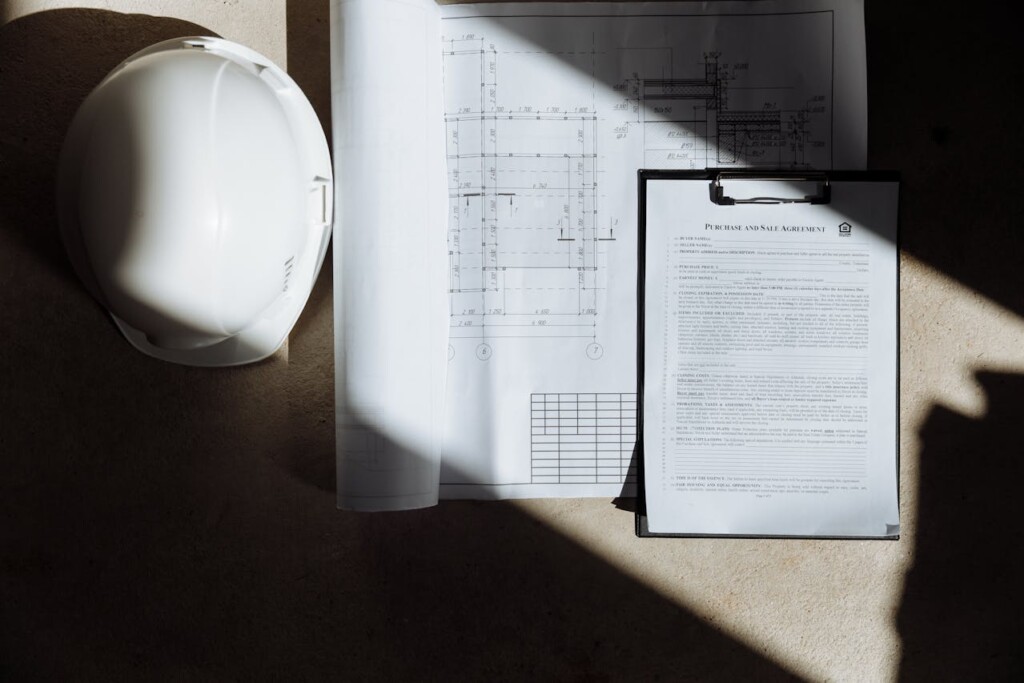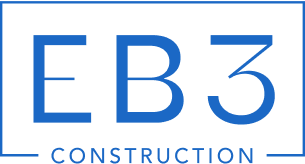Walk into any thriving business and you notice something immediate. The space feels intentional, purposeful, designed for exactly what happens there. That transformation from empty shell to functioning workspace is what we call a commercial finish out.
A commercial finish out is the customization of leased commercial space using construction and design elements like walls, flooring, lighting, electrical systems, HVAC, and plumbing to make it business-ready. The industry uses several terms interchangeably: tenant improvement (TI), build-out, or leasehold improvement. We encounter finish outs in three common scenarios: new construction shell spaces where tenants are the first occupants, second-generation spaces that need reconfiguration from previous use, and expansions or reconfigurations of existing suites. Done well, a finish out shapes brand expression, improves workflow, supports employee satisfaction, and elevates customer experience.
What Are The Core Components And Stages Of A Commercial Finish Out?

Every commercial finish out involves specific construction elements that transform raw space into functional business environments. The physical components typically include interior partitions for creating separate rooms and offices, flooring systems ranging from carpet to specialized surfaces, and comprehensive lighting schemes that address both functional and aesthetic needs.
Electrical and data infrastructure forms the backbone of modern commercial spaces, encompassing power distribution, telecommunications wiring, and security systems. Plumbing installations handle everything from basic restroom facilities to specialized equipment connections, while HVAC modifications ensure proper climate control throughout the reconfigured space.
Paint and finishes provide the visual foundation that reinforces brand identity and creates professional environments. Custom features like millwork, reception desks, and built-in storage solutions often distinguish one business from another, creating memorable spaces that support operational efficiency.
Planning Stage
We begin every commercial finish out with thorough needs assessment to understand how your business operates within physical space. This involves analyzing workflow patterns, staff requirements, and growth projections that influence design decisions throughout the project.
Space programming translates business needs into spatial relationships, determining which functions require proximity and how traffic flows through the environment. We develop preliminary budgets that include a standard 10-15% contingency to address unforeseen conditions common in existing buildings.
Realistic scheduling becomes critical for businesses planning their move-in dates. We coordinate timeline expectations with lease obligations, business operations, and the complex web of approvals required before construction begins.
Design And Approvals Stage
Architectural drawings and engineering specifications provide the technical foundation for all construction activities. These documents detail everything from structural modifications to mechanical systems integration, ensuring code compliance and constructibility before permits are submitted.
ADA compliance verification occurs during design development, addressing accessibility requirements for entrances, exits, restrooms, and workspace accommodations. We coordinate with accessibility consultants when projects involve complex compliance scenarios or specialized business functions.
City permits represent a significant milestone that can impact project timelines substantially. MEP permits cover mechanical, electrical, and plumbing systems, while life safety approvals address fire protection and emergency egress requirements. We manage permit submissions and coordinate with local authorities to minimize approval delays.
Landlord review and approval processes vary significantly between properties and lease agreements. We present design concepts that demonstrate property value enhancement while meeting tenant-specific operational requirements, facilitating smoother approval processes.
Construction And Inspections Stage
Selective demolition launches the physical transformation, carefully removing existing elements while preserving building systems and structural integrity. We coordinate utility shutoffs and protection measures to prevent disruption to adjacent tenants or building operations.
Build-out activities proceed systematically through rough construction, system installations, and finish work. We sequence trades to maximize efficiency while maintaining quality standards and safety protocols throughout occupied buildings.
Change order management becomes essential as unforeseen conditions emerge during construction. We document all modifications to scope, schedule, and budget, ensuring transparent communication with all stakeholders and maintaining project financial controls.
Punch list development occurs as construction nears completion, identifying items requiring correction or completion before final acceptance. We coordinate resolution of punch list items with trade contractors and maintain detailed tracking systems to ensure nothing falls through the cracks.
Inspections and certificate of occupancy acquisition mark the transition from construction to operational space. We schedule and coordinate all required inspections, address any deficiencies promptly, and obtain final approvals necessary for business occupancy.
Closeout And Move-In Stage
Final walk-through procedures involve systematic verification that all systems operate as intended and construction meets approved plans and specifications. We address any remaining issues and coordinate final corrections before project handover.
Warranty documentation compilation ensures proper coverage for both workmanship and manufactured components. We provide comprehensive warranty information and coordinate warranty service procedures for ongoing building system maintenance.
Operations and maintenance manuals deliver essential information for building system operation and care. These documents include equipment specifications, maintenance schedules, vendor contact information, and troubleshooting procedures that support long-term facility management.
Technology setup coordination addresses telecommunications, security systems, and specialized equipment installation that occurs after construction completion. We coordinate with technology vendors and ensure proper integration with building infrastructure.
FF&E installation and staff orientation represent the final steps in space activation. We coordinate furniture delivery and placement, ensuring minimal disruption to business operations while completing the transformation from construction site to functional workspace.
What Does A Commercial Finish Out Cost And Who Pays?
Commercial finish out costs typically range from $15 to $40 per square foot for standard office spaces. Specialized uses command significantly higher budgets. Restaurants often reach $75 to $100 per square foot due to complex kitchen systems and specialized ventilation requirements. Medical facilities and laboratories frequently exceed $100 per square foot, reflecting stringent code requirements and specialized infrastructure needs.
The financial arrangement between landlord and tenant determines who shoulders these costs. We see this negotiated through several common structures, each with distinct advantages depending on project scope and market conditions.
Tenant Improvement Allowance Structures
Most commercial leases address finish out costs through a Tenant Improvement Allowance (TIA). This represents the maximum amount a landlord will contribute toward customizing the space. The three primary TIA structures each serve different project needs and risk profiles.
Fixed amount allowances provide a set dollar figure regardless of actual construction costs. This approach offers budget certainty for landlords while placing cost overrun risk on tenants. Per-square-foot allowances multiply an agreed rate by the leased area, creating scalable budgets that adjust with space size. Percentage-based allowances have landlords fund a predetermined share of total improvement costs, typically requiring detailed cost documentation and approval processes.
Alternative arrangements include rent abatement periods, turnkey build-outs where landlords manage the entire construction process, and building standard allowances covering predetermined finish packages.
Hard Costs Versus Soft Costs
Construction budgets divide into two primary categories with markedly different cost distributions. Hard costs represent the physical construction work and typically consume 75 to 85 percent of total project budgets.
[[artifact_table]] Commercial finish out cost breakdown by hard and soft costs [[/artifact_table]]
Hard costs encompass selective demolition, interior framing and drywall installation, doors and hardware, flooring systems, suspended ceilings, plumbing modifications, electrical and data infrastructure, HVAC adjustments, fire protection systems, custom millwork, paint and finishes, and specialized equipment installations. These expenses add permanent value to the leased space and often qualify for TIA reimbursement.
Soft costs account for 15 to 25 percent of finish out budgets but frequently catch tenants unprepared. Architecture and engineering fees, permit applications and inspections, project management services, legal review costs, construction insurance, testing and commissioning, furniture and equipment procurement, technology installations, telecommunications setup, and moving expenses fall into this category. Many landlords exclude soft costs from TIA coverage or cap their contribution to these expenses.
Negotiation Factors And Strategies
Several key factors influence TIA negotiations and final cost responsibility. Lease term length directly affects landlord willingness to invest in improvements, with longer commitments typically securing higher allowances. Tenant creditworthiness impacts risk assessment, as financially stable tenants often negotiate more favorable terms.
Building class and condition play significant roles in cost allocation. Class A properties in prime markets may offer substantial allowances to attract quality tenants, while older buildings might require tenants to address infrastructure deficiencies. Current market conditions affect negotiating leverage, with high vacancy rates typically favoring tenant positions.
The permanence and value-add potential of proposed improvements influences landlord contribution levels. Upgrades that enhance long-term property value often receive more generous allowance treatment than tenant-specific customizations.
Effective negotiation strategies include obtaining multiple contractor bids to establish realistic cost baselines and demonstrate due diligence. Understanding local market standards for similar spaces provides negotiating benchmarks. Clearly articulating how improvements add lasting property value strengthens allowance requests. Establishing contractor approval processes and change order protocols protects both parties during construction. Clarifying the treatment of unused allowance funds prevents disputes and may create opportunities for rent credits or future improvement funding.
How Long Does A Commercial Finish Out Take?

Commercial finish out timelines span a wide range based on project complexity and permit requirements. A straightforward office space build-out moves much faster than converting raw shell space into a medical facility or restaurant.
Simple office finish outs typically require 9 to 20 weeks total. We allocate 2 to 4 weeks for planning and design, another 2 to 6 weeks for permits, 4 to 8 weeks for construction, and 1 to 2 weeks for final inspections and move-in coordination. These projects involve standard partitions, basic electrical and data infrastructure, and conventional finishes.
Moderate retail and restaurant projects demand considerably more time, averaging 20 to 39 weeks. The planning phase extends to 4 to 8 weeks due to specialized requirements like kitchen equipment layouts or customer flow optimization. Permitting stretches to 6 to 12 weeks because restaurants require health department approvals and retail spaces often need signage permits and fire safety reviews. Construction spans 8 to 16 weeks, accounting for specialized trades and custom millwork. Final inspections and move-in preparation take 2 to 3 weeks.
Complex Projects Require Extended Timelines
Medical offices, laboratories, and other specialized facilities push timelines to 35 to 60 weeks. Planning and design consume 8 to 16 weeks as we coordinate with specialized consultants and ensure compliance with industry-specific codes. Permitting alone takes 8 to 16 weeks due to extensive regulatory reviews for life safety, accessibility, and specialized systems like medical gas or laboratory ventilation.
Construction phases for complex projects run 16 to 24 weeks, reflecting the precision required for specialized installations and the coordination of multiple trades. Final inspections extend to 3 to 4 weeks as various authorities review different building systems and issue the certificate of occupancy.
Remodel-Heavy Projects Face Additional Variables
When finish out work involves significant remodeling of existing spaces, we typically see design and planning phases extend to 1 to 3 months. The existing conditions assessment, structural evaluations, and coordination with building systems require thorough documentation before construction begins.
Permitting for remodel projects often takes 3 to 5 weeks, though this varies significantly by jurisdiction. Some municipalities expedite tenant improvement permits while others require full plan reviews similar to new construction projects.
Construction duration ranges from 3 to 6 months for remodel-heavy scopes. Several factors drive these extended timelines. Demolition work reveals unexpected conditions like outdated electrical systems or structural modifications needed for new layouts. Utilities upgrades become necessary when existing HVAC, electrical, or plumbing systems cannot support the new space requirements.
Material lead times significantly impact construction schedules. Custom millwork, specialized flooring, or energy-efficient HVAC equipment often require 6 to 12 weeks for fabrication and delivery. Square footage directly correlates with construction duration as larger spaces require more coordination, materials, and installation time.
We recommend starting finish out planning early in the lease negotiation process to accommodate these variables. Building buffer time into schedules protects against unforeseen delays from permit reviews, material availability, or construction complications. Local permitting practices vary dramatically, so understanding jurisdictional requirements helps establish realistic expectations for project completion.
What Best Practices, Trends, And Pitfalls Should Teams Expect?
Successful commercial finish out projects demand disciplined execution across planning, construction, and closeout phases. When we approach these projects with clear protocols and realistic expectations, teams consistently deliver better outcomes while avoiding costly mistakes that derail schedules and budgets.
Essential Best Practices For Project Success
We invest significant time in upfront planning because thorough preparation prevents expensive surprises downstream. Defining scope with precision eliminates ambiguity that leads to change order disputes and budget overruns. Clear documentation at every stage protects all parties when questions arise about specifications or approved modifications.
Weekly site meetings keep communication flowing between trades, architects, and property managers. We document decisions, track progress against milestones, and address issues before they compound. Maintaining a 10-15% contingency fund provides cushion for unforeseen conditions without forcing difficult budget conversations mid-project.
Quality control protocols ensure workmanship meets specifications and code requirements. Regular inspections by qualified personnel catch defects early when corrections cost less and cause minimal schedule disruption.
Current Design Trends Shaping Commercial Spaces
Energy-efficient systems dominate modern finish out specifications. LED lighting reduces operating costs while smart sensors and occupancy controls optimize energy consumption based on actual usage patterns. Advanced HVAC systems with improved ventilation capabilities address health concerns while maintaining comfort levels.
Low-VOC paints and finishes support indoor air quality standards that tenants increasingly expect. Water-conserving fixtures align with sustainability goals while reducing utility expenses over the lease term. Touchless access systems and fixtures gained prominence following health awareness shifts in recent years.
Modular wall systems provide flexibility for future reconfigurations without extensive demolition. When businesses need to adapt layouts for changing operations, these systems reduce disruption and renovation costs significantly.
Building The Right Project Team
Experienced tenant representation brokers help negotiate favorable TI terms and understand local market standards. Architects and designers familiar with commercial code requirements streamline the approval process while creating functional, compliant layouts.
Project managers coordinate multiple trades and maintain schedule discipline throughout construction. In complex jurisdictions with lengthy approval processes, permit expeditors navigate bureaucratic requirements efficiently to prevent delays.
Code compliance remains non-negotiable across all project phases. ADA accessibility standards apply to most commercial spaces, while fire and life safety systems require careful coordination with local authorities. Industry-specific requirements for medical, food service, or specialized uses demand expertise in relevant regulations.
Common Pitfalls That Derail Projects
Rushed planning creates cascading problems throughout construction. When scope definitions lack precision, scope creep becomes inevitable as stakeholders discover overlooked requirements or change preferences mid-stream.
Underestimating soft costs catches many teams unprepared. Permit fees, professional services, and testing requirements add substantial expense beyond basic construction activities. Poor change order management compounds these issues when modifications lack proper documentation or cost analysis.
Ignoring code requirements during design leads to expensive corrections during construction or failed inspections that delay occupancy. Early coordination with building officials prevents costly redesign efforts.
Critical Closeout Requirements
Punch list completion requires systematic attention to detail. We coordinate final inspections methodically, addressing deficiencies promptly to maintain certificate of occupancy schedules. Warranty documentation protects tenants with clear coverage for both workmanship and manufacturer defects.
Operations and maintenance manuals provide facility managers with essential system information for ongoing performance. Preventive maintenance plans help tenants protect their investment while maintaining optimal building performance throughout the lease term.
Conclusion And Next Steps

A commercial finish out transforms raw shell spaces and outdated second-generation areas into functional, branded environments that support business operations. The process requires careful coordination between design vision and construction reality, balancing tenant needs with landlord requirements while navigating complex permitting and compliance demands.
Successful delivery hinges on establishing clear project fundamentals from the start. We define tenant needs through thorough space programming, align project scope with available tenant improvement allowances, and secure favorable lease terms before any construction work begins. Building realistic schedules with appropriate contingency planning protects against the inevitable delays that arise during permitting and material procurement. Throughout the design phase, we coordinate architectural drawings with engineering specifications while ensuring ADA compliance and local building code adherence.
The construction phase demands meticulous oversight of punch list completion, change order management, and final inspections leading to certificate of occupancy approval. Project closeout extends beyond construction completion to include warranty documentation, O&M manuals, and preventive maintenance planning that protects the investment long term. Teams that follow these systematic stages while monitoring cost drivers and maintaining experienced coordination find themselves with smooth transitions from construction completion to business occupancy.
Ready to transform your commercial space into a functional environment that serves your business needs? Contact EB3 Construction to discuss your tenant improvement project.




